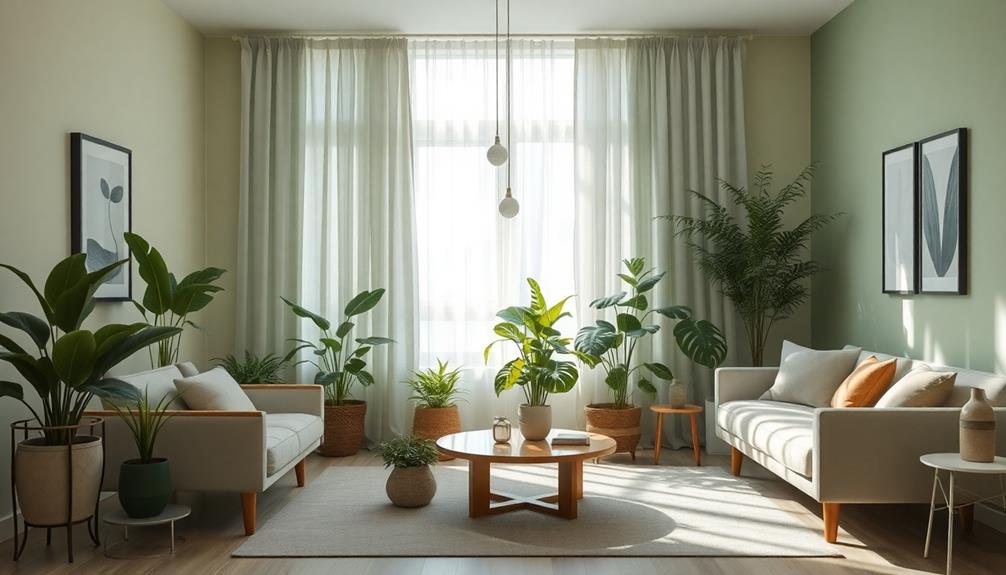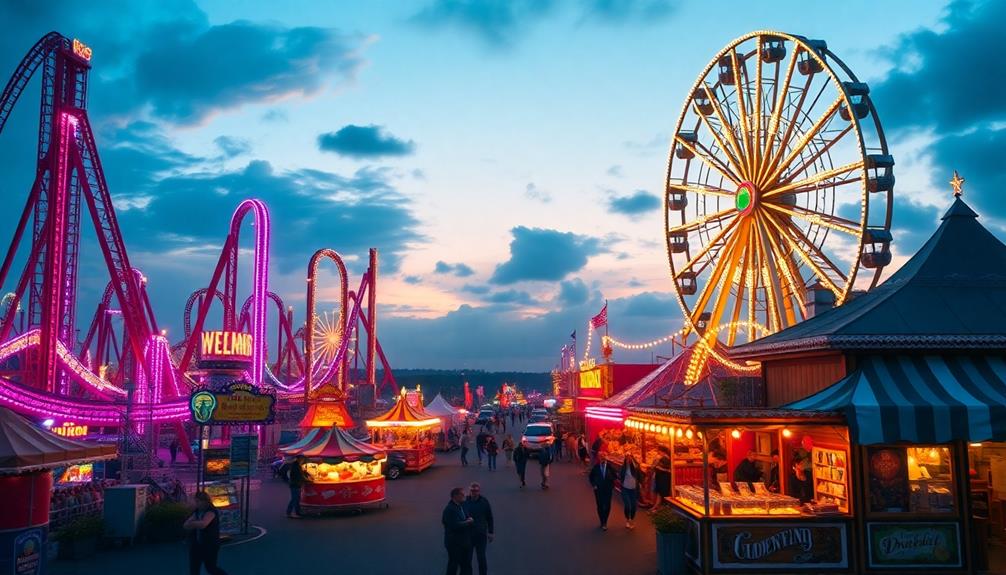The Feng Shui color rule that can completely change your space involves understanding how colors impact energy, or chi. Each color corresponds to one of the five elements—fire, earth, metal, water, and wood. By choosing direction-specific colors, like calming blues in the North or warm earthy tones in the South, you enhance balance and harmony. Remember to limit bold colors to avoid overwhelming your space. Regularly reassessing your color choices will keep energy flowing positively. This simple yet powerful approach can elevate your environment greatly, and there's so much more to discover about creating a harmonious home!
Key Takeaways
- Colors significantly impact emotional and physical well-being, making thoughtful color choices essential for enhancing your space's energy flow.
- Each color corresponds to an element in Feng Shui; use specific colors to balance and harmonize the five elements in your space.
- Direction-specific color recommendations help enhance energy; for example, use blue and black in the North and earthy tones in the South.
- Limit bold color usage to maintain harmony, ideally restricting them to about 1/9 of the total space to avoid clutter.
- Thoughtful color combinations, like salmon or turquoise, can stimulate abundance and promote dynamic growth, enhancing overall ambiance.
Understanding Feng Shui Basics

Feng Shui is often misunderstood, but it's a powerful practice that can transform your living space and well-being. At its core, Feng Shui focuses on enhancing the flow of chi, or energy, in your environment. By applying the principles of Feng Shui, you can create balance and harmony in your home, leading to a more positive energy flow.
Incorporating elements such as Indonesian decorative pillows can add vibrant colors and intricate patterns that not only enhance the aesthetic but also promote comfort and cultural resonance.
One significant aspect of Feng Shui is understanding the five elements: wood, fire, earth, metal, and water. Each element corresponds to a cardinal direction and influences different life areas. For example, the water element, associated with the north, promotes career growth and abundance. You can harness this by incorporating water features or colors that represent this element.
The Bagua map is an essential tool in this practice, helping you identify which areas of your space correspond to your life goals. Regular decluttering and maintaining cleanliness are also important in promoting positive energy flow.
The Importance of Color Energy
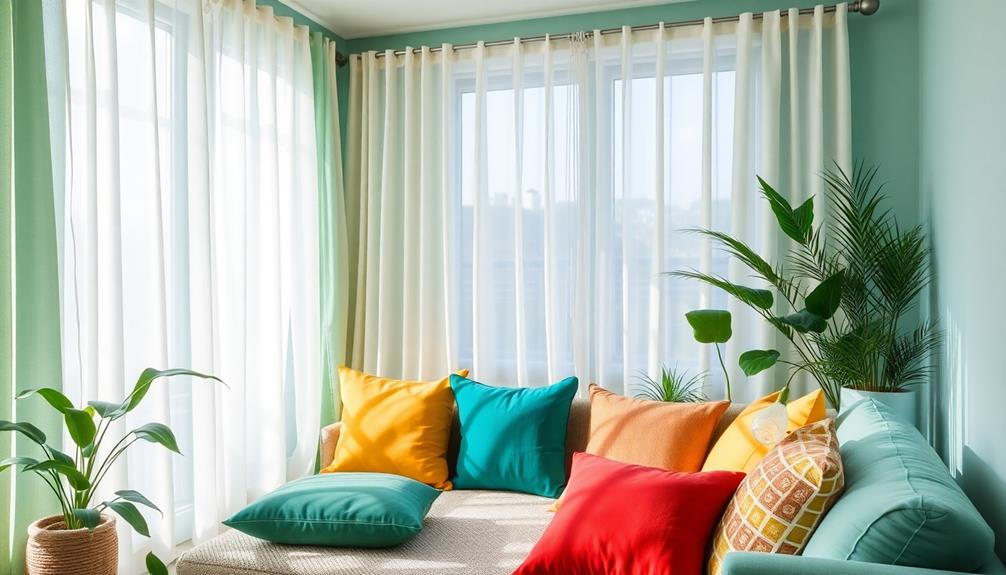
Color energy greatly impacts your living space, as each hue resonates with specific elements that can enhance your emotional and physical well-being. For example, colors like blue and black embody water energy, promoting creativity and calmness.
By applying Feng Shui rules, you can create a balanced and harmonious environment that supports your needs. Incorporating natural materials and earth tones, as seen in Balinese design concepts, can further enhance the calming effects of color.
Understanding how colors interact within the creative cycle is key. For instance, shades of red or orange in the East can weaken the wood element, while earth tones in the South bolster the fire element. By choosing colors carefully, you can modify the effects of these elements to foster a more peaceful and calming atmosphere.
It's also crucial to recognize the destructive cycle of colors. For instance, water can extinguish fire, leading to negative energy and imbalance if not managed properly.
Regularly assess your color combinations to guarantee they maintain a harmonious flow of energy throughout your space. This thoughtful approach not only enhances your surroundings but also promotes overall well-being, allowing you to enjoy a vibrant, nurturing environment.
Colors and Their Elemental Associations
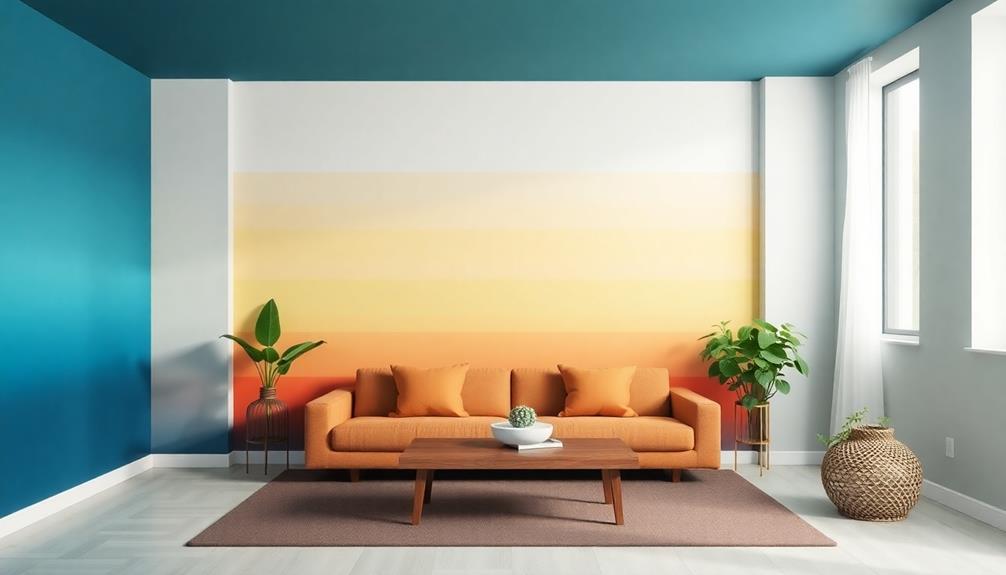
In the domain of design and energy, every hue is tied to one of the five elements: fire, earth, metal, water, and wood. In Feng Shui, understanding these colors and their elemental associations is fundamental for creating a harmonious environment.
Incorporating elements of traditional Indonesian style home decor can further enhance the ambiance by emphasizing harmony with nature. Fire is represented by red, which inspires passion and energy. Earth tones like yellow and brown promote stability and connection. Metal, shown through white and metallic shades, offers clarity and precision. Water is embodied by blue and black, fostering calmness and introspection, while green symbolizes wood, encouraging growth and liveliness.
To maintain positive energy in your space, it's essential to balance these elements. The creative cycle flows from fire to earth, then to metal, water, wood, and back to fire, strengthening relationships and enhancing the overall energy.
However, the exhaustive cycle can weaken elements if not carefully managed, like fire depleting wood.
Directional associations also play a role in home design. For example, blue and black are perfect in the north to boost water energy, while warmer shades like red or orange in the east can help weaken excessive wood energy, ensuring a balanced atmosphere in your home.
Direction-Specific Color Recommendations
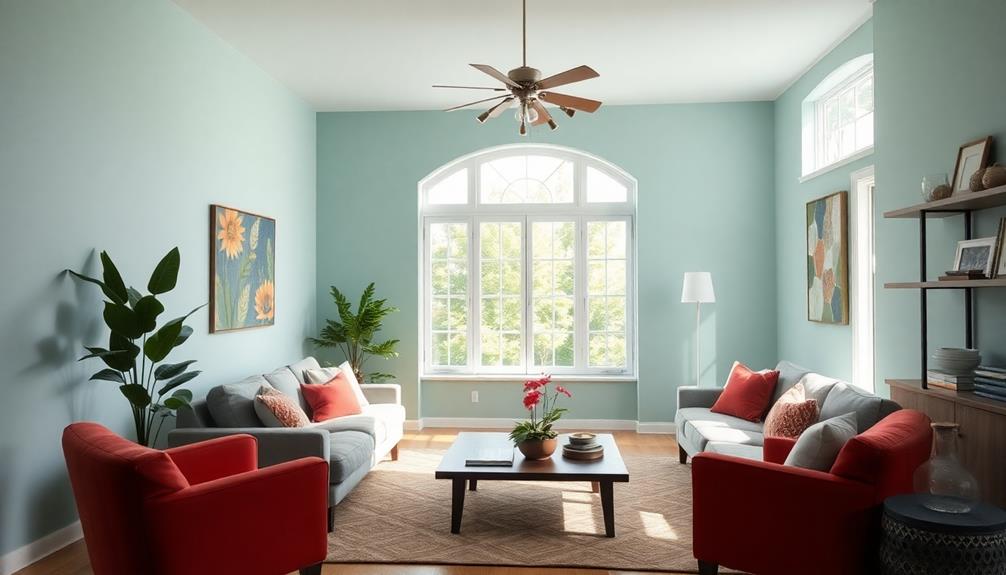
When it comes to direction-specific color recommendations, you'll want to pay close attention to the North and South.
In the North, blue and black are your go-to choices to enhance water energy, while in the South, mild reds and earthy tones will keep the fire element balanced.
Incorporating elements of traditional artistry like Indonesian decor masks can also enrich your space.
Avoiding certain colors in these directions can help you create a harmonious living space.
North Direction Colors
The North direction, linked to the water element, thrives on specific color choices that enhance its energy. To create a harmonious space, focus on incorporating blue and black colors. These shades not only strengthen the water element but also promote positive energy that supports your well-being.
Additionally, consider integrating unique decor pieces, such as Indonesian masks, to enrich your environment with cultural significance and artistic flair. These masks can serve as striking focal points that complement your color scheme and enhance the overall ambiance of your space, transforming it into a conversation starter and educational piece about the rich cultural heritage of Indonesia.
Here are some key color recommendations for the North direction:
- Deep blue: This color fosters concentration and creativity, perfect for workspaces.
- Black: A powerful color that enhances the water element, providing a calming influence.
- Light red or pink: Incorporating these fire element colors can add comfort, especially in bedrooms.
- Avoid wooden colors: Particularly greens, as they weaken the water element's influence.
In your Feng Shui design, regularly reassessing your color choices in the North direction helps maintain balanced energy.
South Direction Colors
Embracing the vibrant energy of the South direction can elevate your space, as this area is linked to the fire element. To harness the positive energy of this direction, consider using warm colors like light red and pink. These shades not only infuse your environment with warmth and comfort but also create a lively atmosphere.
For a truly inviting ambiance, you might also explore coastal color palettes that complement these tones. Remember, though, it's best to avoid using full red colors excessively; limit them to no more than 1/9 of your home to prevent overwhelming energy.
Incorporating earth tones alongside your warm colors is essential for maintaining balance. Earth tones foster stability and grounding, counteracting the dynamic nature of the fire element. This combination can create a harmonious environment, especially in bedrooms located in the South direction, where comfort is key.
To maximize the benefits of Feng Shui, get creative with your color palette. Use light reds and pinks for accents, while allowing earth tones to dominate the space.
Creative and Exhaustive Color Cycles
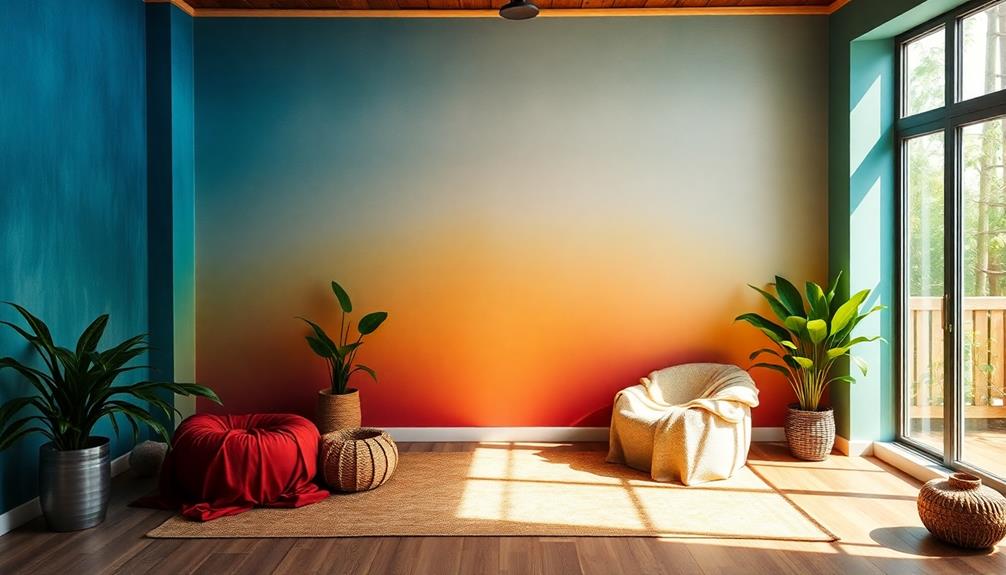
Understanding the creative and exhaustive color cycles in Feng Shui can transform your space into a sanctuary of positive energy.
The creative cycle promotes a harmonious flow where colors associated with each element support one another—like Fire energizing Earth or Wood fueling Fire. Incorporating unique art pieces, such as the Face Indonesian Decor Mask, can enhance the aesthetic while aligning with these cycles.
Conversely, the exhaustive cycle reveals how colors can weaken each other, leading to potential energy imbalance, such as Fire diminishing Wood.
To effectively harness these cycles, consider these key points:
- Creative Cycle: Use colors that embody growth and liveliness.
- Exhaustive Cycle: Avoid color combinations that may lead to fatigue.
- Metal Energy: Incorporate metallic hues to enhance clarity and precision.
- Wood Energy: Add greens and browns to foster renewal and stability.
Balancing Colors for Harmony

Harmony in your living space can be achieved by carefully balancing colors that resonate with the five elements of Feng Shui: fire, earth, metal, water, and wood. Each element is associated with specific colors that promote balance and positive Chi energy flow.
For instance, vibrant shades of red can enhance the fire element, uplifting the ambiance in the South. If you're looking to bring in water energy, consider incorporating calming blues and blacks in the North to foster tranquility. This quest for balance often aligns with the eclectic style's diverse influences, appealing to those who seek a unique expression of their individuality.
It's crucial to understand that each direction has its favorable and unfavorable colors. Earthy tones work wonders in the Northeast and Southwest, grounding the energy in those areas.
To create a dynamic atmosphere, combining colors can also be effective. Using turquoise blends the wood and water energies, promoting movement and growth within your space.
Regularly evaluating and adjusting your color scheme guarantees that you maintain balance as your needs change. This adaptability not only enhances the energy in your home but also boosts your overall comfort.
Practical Tips for Color Application
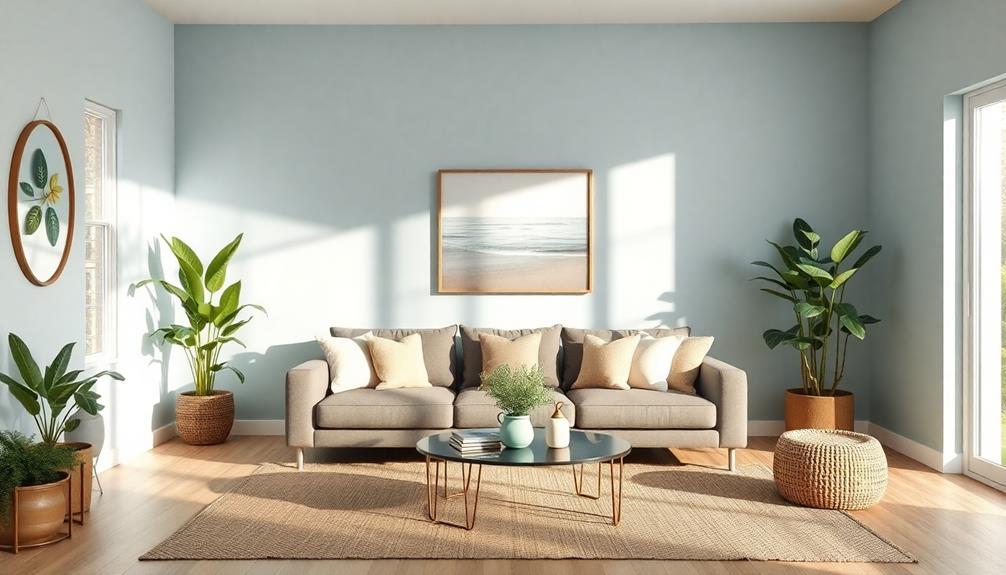
When you apply color in your space, consider how each hue interacts with the elements and directions of Feng Shui. Using the right colors can enhance energy flow and create a harmonious environment.
Additionally, incorporating features inspired by tropical villa designs can further elevate the ambiance of your space. Here are some practical tips for color application:
- Use blue and black in the North for water energy, and earthen tones in the South to connect with the fire element.
- Incorporate shades of red or orange in the East to weaken wood energies, while green tones can promote relaxation and support growth.
- Balance dominant colors by limiting bold shades to about 1/9 of the space. This helps avoid clutter and overwhelming energy.
- Regularly assess your color choices to guarantee they continue to align with your personal and environmental changes.
Color Combinations for Enhanced Energy

Color combinations play an essential role in enhancing the energy of your space. By thoughtfully selecting hues, you can create harmony and promote a vibrant atmosphere.
Incorporating elements from Southeast Asia Decor, such as vibrant textiles and handcrafted items, can further enrich your environment with cultural significance. For example, pairing salmon, which represents the earth and fire element, can stimulate abundance and encourage lively conversations.
If you're aiming for a dynamic environment that inspires growth, consider integrating turquoise, combining wood and water qualities to foster movement.
On the other hand, if tranquility is your goal, lavender, a blend of blue and purple, evokes calmness and spirituality, making it ideal for bedrooms or meditation areas.
Utilizing these specific color combinations not only enhances energy but also contributes to a cohesive aesthetic.
Transforming Spaces With Feng Shui
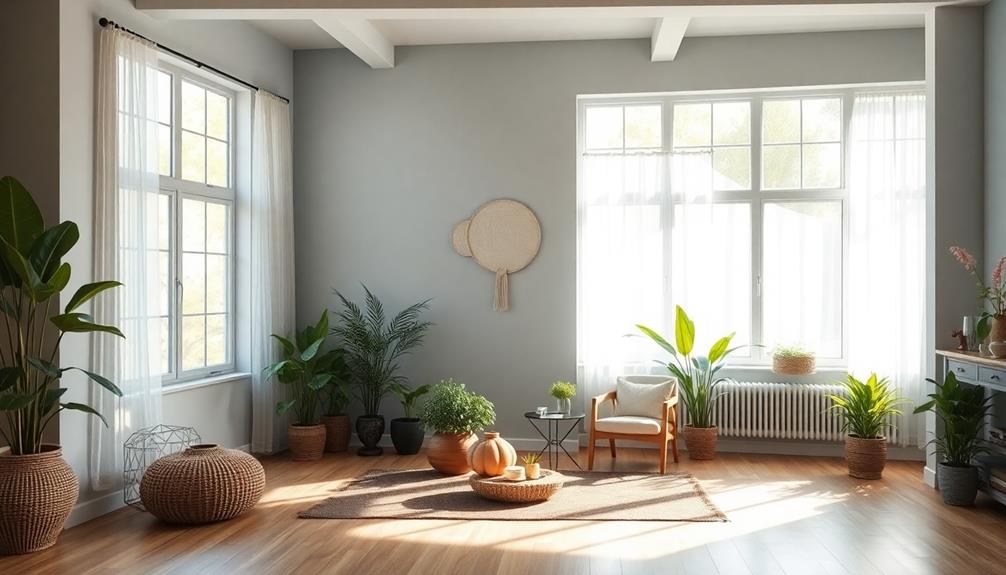
Transforming your space with Feng Shui involves more than just rearranging furniture; it requires a thoughtful approach to how colors influence energy flow.
By strategically incorporating colors that correspond to elemental energies, you can create an environment that promotes harmony and well-being. Consider integrating elements from expert tropical design to enhance the natural aesthetic of your home while applying these color principles.
- Use shades of blue and black in the North to enhance creativity and concentration.
- Incorporate warm earthy tones in the South to foster passion and social connectivity.
- Introduce red or orange in the East to balance excess wood energy, making your space more inviting.
- Choose earthy tones like brown, yellow, and pink in the Northeast and Southwest to strengthen relationships and encourage cheerfulness.
Regularly evaluating and adjusting your color schemes not only maintains a positive energy flow but also keeps your living spaces feeling fresh.
By transforming your space through the mindful use of colors, you not only enhance the energy within but also align your environment with your desired outcomes.
Embrace the power of Feng Shui colors, and watch how your space transforms into a sanctuary of balance and liveliness. By thoughtfully incorporating these harmonious hues, you can create an environment that uplifts your energy and fosters positivity. Whether it’s adding earthy tones for grounding or vibrant reds for passion, every choice contributes to the flow of good chi. Explore feng shui tips for inviting spaces to discover how specific colors can enhance different areas of your home and support your well-being.
Frequently Asked Questions
How to Feng Shui Your Space?
To feng shui your space, incorporate calming colors like blue and green in the North and East for tranquility. Balance hues, use earthen tones in the South-West, and assess your color choices regularly for positive energy.
What Colors Should Be Avoided in Feng Shui?
Think of your space as a garden; avoid dark colors that choke growth, sharp reds that overwhelm, and excessive grey that dulls vibrancy. Clear out broken items, too, to let positive energy flourish.
What Are the Best Colors for Feng Shui Living Room?
For a Feng Shui living room, choose earth tones and mild reds for warmth. Incorporate blue or black for balance, and add shades of salmon or green to encourage conversation and liveliness. Keep it cohesive!
What Is the Color Theory of Feng Shui?
Imagine a garden where each flower thrives through the right sunlight. In Feng Shui, colors act like sunlight, nurturing energy flow. You'll discover how hues influence your space, enhancing your emotional well-being and harmony.
Conclusion
Embracing the Feng Shui color rule can truly transform your space into a sanctuary of energy and balance. Imagine stepping into a room that not only looks stunning but also feels invigorating and harmonious. By thoughtfully choosing colors that resonate with your intentions, you're not just decorating—you're creating an environment that nurtures your well-being. So, what colors are you ready to invite into your life? Immerse yourself in this vibrant journey and watch your space come alive!
